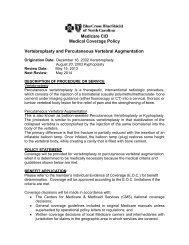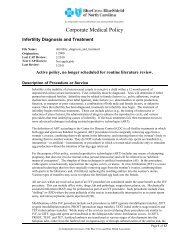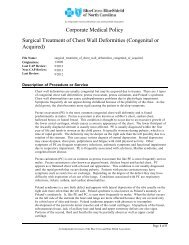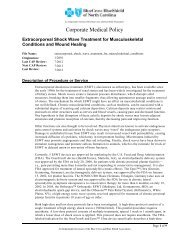Intensity Modulated Radiation Therapy (IMRT) of Breast and Lung
Intensity Modulated Radiation Therapy (IMRT) of Breast and Lung
Intensity Modulated Radiation Therapy (IMRT) of Breast and Lung
You also want an ePaper? Increase the reach of your titles
YUMPU automatically turns print PDFs into web optimized ePapers that Google loves.
Corporate Medical Policy<br />
<strong>Intensity</strong> <strong>Modulated</strong> <strong>Radiation</strong> <strong>Therapy</strong> (<strong>IMRT</strong>) <strong>of</strong> <strong>Breast</strong> <strong>and</strong><br />
<strong>Lung</strong><br />
File Name: intensity_modulated_radiation_therapy_imrt_<strong>of</strong>_breast_<strong>and</strong>_lung<br />
Origination:<br />
Last CAP Review:<br />
Next CAP Review:<br />
Last Review:<br />
11/2009<br />
5/2013<br />
5/2014<br />
5/2013<br />
Description <strong>of</strong> Procedure or Service<br />
<strong>Radiation</strong> therapy is an integral component in the treatment <strong>of</strong> breast <strong>and</strong> lung cancers. <strong>Intensity</strong><br />
modulated radiation therapy (<strong>IMRT</strong>) has been proposed as a method <strong>of</strong> radiation therapy that allows<br />
adequate radiation therapy to the tumor while minimizing the radiation dose to surrounding normal tissues<br />
<strong>and</strong> critical structures.<br />
For certain stages <strong>of</strong> many cancers, including breast <strong>and</strong> lung, r<strong>and</strong>omized clinical trials have shown that<br />
postoperative radiation therapy improves outcomes for operable patients. Adding radiation to<br />
chemotherapy also improves outcomes for those with inoperable lung tumors that have not metastasized<br />
beyond regional lymph nodes.<br />
<strong>Radiation</strong> techniques<br />
Conventional external beam radiation<br />
Over the past several decades, methods to plan <strong>and</strong> deliver radiation therapy have evolved in ways that<br />
permit more precise targeting <strong>of</strong> tumors with complex geometries. Most early trials used two-dimensional<br />
treatment planning based on flat images, <strong>and</strong> radiation beams with cross-sections <strong>of</strong> uniform intensity that<br />
were sequentially aimed at the tumor along 2 or 3 intersecting axes. Collectively, these methods are<br />
termed conventional external beam radiation therapy (EBRT).<br />
3-dimensional conformal radiation (3D-CRT) treatment planning evolved by using 3-dimensional images,<br />
usually from computed tomography (CT) scans, to delineate the boundaries <strong>of</strong> the tumor <strong>and</strong> discriminate<br />
tumor tissue from adjacent normal tissue, <strong>and</strong> nearby organs at risk for radiation damage. Computer<br />
algorithms were developed to estimate cumulative radiation dose delivered to each volume <strong>of</strong> interest by<br />
summing the contribution from each shaped beam. Methods also were developed to position the patient<br />
<strong>and</strong> the radiation portal reproducibly for each fraction, <strong>and</strong> immobilize the patient, thus maintaining<br />
consistent beam axes across treatment sessions. Collectively, these methods are termed 3-dimensional<br />
conformal radiation therapy (3D-CRT).<br />
<strong>Intensity</strong>-modulated radiation therapy (<strong>IMRT</strong>)<br />
<strong>IMRT</strong>, which uses computer s<strong>of</strong>tware, CT images <strong>and</strong> magnetic resonance imaging (MRI), <strong>of</strong>fers better<br />
conformality than 3D-CRT as it is able to modulate the intensity <strong>of</strong> the overlapping radiation beams<br />
projected on the target <strong>and</strong> to use multiple shaped treatment fields. It uses a device (a multileaf collimator,<br />
MLC) which, coupled to a computer algorithm, allows for “inverse” treatment planning. The radiation<br />
oncologist delineates the target on each slice <strong>of</strong> a CT scan <strong>and</strong> specifies the target’s prescribed radiation<br />
dose, acceptable limits <strong>of</strong> dose heterogeneity within the target volume, adjacent normal tissue volumes to<br />
avoid, <strong>and</strong> acceptable dose limits within the normal tissues. Based on these parameters computer s<strong>of</strong>tware<br />
optimizes the location, shape <strong>and</strong> intensities <strong>of</strong> the beams ports, to achieve the treatment plan’s goals.<br />
An Independent Licensee <strong>of</strong> the Blue Cross <strong>and</strong> Blue Shield Association<br />
Page 1 <strong>of</strong> 7
<strong>Intensity</strong> <strong>Modulated</strong> <strong>Radiation</strong> <strong>Therapy</strong> (<strong>IMRT</strong>) <strong>of</strong> <strong>Breast</strong> <strong>and</strong><br />
<strong>Lung</strong><br />
Policy<br />
Increased conformality may permit escalated tumor doses without increasing normal tissue toxicity <strong>and</strong><br />
thus may improve local tumor control, with decreased exposure to surrounding, normal tissues, potentially<br />
reducing acute <strong>and</strong> late radiation toxicities. Better dose homogeneity within the target may also improve<br />
local tumor control by avoiding under-dosing within the tumor <strong>and</strong> may decrease toxicity by avoiding<br />
overdosing.<br />
Since most tumors move as patients breathe, dosimetry with stationary targets may not accurately reflect<br />
doses delivered within target volumes <strong>and</strong> adjacent tissues in patients. Furthermore, treatment planning<br />
<strong>and</strong> delivery are more complex, time-consuming, <strong>and</strong> labor-intensive for <strong>IMRT</strong> than for 3D-CRT. Thus,<br />
clinical studies must test whether <strong>IMRT</strong> improves tumor control or reduces acute <strong>and</strong> late toxicities when<br />
compared with 3D-CRT.<br />
Methodological issues with <strong>IMRT</strong> studies<br />
Multiple-dose planning studies have generated 3D-CRT <strong>and</strong> <strong>IMRT</strong> treatment plans from the same scans,<br />
then compared predicted dose distributions within the target <strong>and</strong> in adjacent organs at risk. Results <strong>of</strong> such<br />
planning studies show that <strong>IMRT</strong> improves on 3D-CRT with respect to conformality to, <strong>and</strong> dose<br />
homogeneity within, the target. Dosimetry using stationary targets generally confirms these predictions.<br />
Thus, radiation oncologists hypothesized that <strong>IMRT</strong> may improve treatment outcomes compared with<br />
those <strong>of</strong> 3D-CRT. However, these types <strong>of</strong> studies <strong>of</strong>fer indirect evidence on treatment benefit from<br />
<strong>IMRT</strong> <strong>and</strong> it is difficult to relate results <strong>of</strong> dosing studies to actual effects on health outcomes.<br />
Comparative studies <strong>of</strong> radiation-induced side effects from <strong>IMRT</strong> versus alternative radiation delivery are<br />
probably the most important type <strong>of</strong> evidence in establishing the benefit <strong>of</strong> <strong>IMRT</strong>. Such studies would<br />
answer the question <strong>of</strong> whether the theoretical benefit <strong>of</strong> <strong>IMRT</strong> in sparing normal tissue translates into<br />
real health outcomes. Single-arm series <strong>of</strong> <strong>IMRT</strong> can give some insights into the potential for benefit,<br />
particularly if an adverse effect that is expected to occur at high rates is shown to decrease by a large<br />
amount. Studies <strong>of</strong> treatment benefit are also important to establish that <strong>IMRT</strong> is at least as good as other<br />
types <strong>of</strong> delivery, but in the absence <strong>of</strong> such comparative trials, it is likely that benefit from <strong>IMRT</strong> is at<br />
least as good as with other types <strong>of</strong> delivery.<br />
***Note: This Medical Policy is complex <strong>and</strong> technical. For questions concerning the technical<br />
language <strong>and</strong>/or specific clinical indications for its use, please consult your physician.<br />
BCBSNC will provide coverage for <strong>Intensity</strong> <strong>Modulated</strong> <strong>Radiation</strong> <strong>Therapy</strong> (<strong>IMRT</strong>) <strong>of</strong> the breast<br />
<strong>and</strong> lung when the criteria below are met.<br />
Benefits Application<br />
This medical policy relates only to the services or supplies described herein. Please refer to the Member's<br />
Benefit Booklet for availability <strong>of</strong> benefits. Member's benefits may vary according to benefit design;<br />
therefore member benefit language should be reviewed before applying the terms <strong>of</strong> this medical policy.<br />
When <strong>Intensity</strong> <strong>Modulated</strong> <strong>Radiation</strong> <strong>Therapy</strong> (<strong>IMRT</strong>) <strong>of</strong> the breast <strong>and</strong> lung is<br />
covered<br />
<strong>Intensity</strong>-modulated radiation therapy (<strong>IMRT</strong>) may be considered medically necessary as a technique to<br />
An Independent Licensee <strong>of</strong> the Blue Cross <strong>and</strong> Blue Shield Association<br />
Page 2 <strong>of</strong> 7
<strong>Intensity</strong> <strong>Modulated</strong> <strong>Radiation</strong> <strong>Therapy</strong> (<strong>IMRT</strong>) <strong>of</strong> <strong>Breast</strong> <strong>and</strong><br />
<strong>Lung</strong><br />
treat breast cancer when at least one <strong>of</strong> the following four conditions (A, B, C, or D) is met:<br />
A. For members receiving treatment to the whole left breast for left-sided breast cancer after breast<br />
conserving surgery:<br />
1. When cardiac toxicity cannot be avoided by alternative radiation techniques; AND<br />
2. <strong>IMRT</strong> dosimetry for a set <strong>of</strong> beams beyond traditional “opposed tangents” demonstrates reduced<br />
cardiac toxicity. (See policy guidelines).<br />
B. For members with large breast volume:<br />
1. When treatment planning with 3D conformal, including the use <strong>of</strong> wedges <strong>and</strong> field-in-field<br />
techniques, <strong>and</strong> the use <strong>of</strong> higher photon energies (e.g. 10-16 MV), results in hot spots (focal<br />
regions with dose variation greater than 10% <strong>of</strong> target); AND<br />
2. The hot spots are able to be avoided by adding additional beam orientations (i.e. beyond<br />
tangents) with <strong>IMRT</strong>. (See policy guidelines).<br />
C. For members with recurrent tumors that have been previously irradiated, with or without an intact<br />
breast:<br />
1. When treatment planning with 3D conformal (including the use <strong>of</strong> wedges <strong>and</strong> field-in-field<br />
techniques, <strong>and</strong> the use <strong>of</strong> higher photon energies (e.g. 10-16 MV) results in unsafe doses to the<br />
lung, heart or other adjacent structures; AND<br />
2. <strong>IMRT</strong> dosimetry for a set <strong>of</strong> beams beyond traditional “opposed tangents” (with or without a<br />
separate field directed to the medial chest wall) demonstrates reduced risk <strong>of</strong> toxicity to those<br />
adjacent structures. (See policy guidelines).<br />
D. For members with target tissues that include the far medial chest wall, internal mammary nodal area<br />
or sternum, with or without an intact breast:<br />
1. When treatment planning with 3D conformal (including the use <strong>of</strong> wedges <strong>and</strong> field-in-field<br />
techniques, <strong>and</strong> the use <strong>of</strong> higher photon energies (e.g. 10-16 MV) results in unsafe doses to the<br />
lung, heart or other adjacent structures; AND<br />
2. <strong>IMRT</strong> dosimetry for a set <strong>of</strong> beams with orientations beyond traditional “opposed tangents”<br />
(with or without a separate field directed to the medial chest wall) demonstrates reduced risk <strong>of</strong><br />
toxicity to those adjacent structures. (See policy guidelines).<br />
<strong>Intensity</strong>-modulated radiation therapy (<strong>IMRT</strong>) may be considered medically necessary as a technique to<br />
deliver radiation therapy in patients with lung cancer when all (A, B, <strong>and</strong> C) <strong>of</strong> the following conditions<br />
have been met:<br />
A. <strong>Radiation</strong> therapy is being given with curative intent; AND<br />
B. One <strong>of</strong> the following four conditions (1, 2, 3, or 4) applies:<br />
1. 3D conformal will expose >35% <strong>of</strong> normal lung tissue to more than 20 Gy dose-volume (V20);<br />
AND<br />
<strong>IMRT</strong> dosimetry demonstrates an absolute reduction in the V20 to at least 10% below the V20<br />
An Independent Licensee <strong>of</strong> the Blue Cross <strong>and</strong> Blue Shield Association<br />
Page 3 <strong>of</strong> 7
<strong>Intensity</strong> <strong>Modulated</strong> <strong>Radiation</strong> <strong>Therapy</strong> (<strong>IMRT</strong>) <strong>of</strong> <strong>Breast</strong> <strong>and</strong><br />
<strong>Lung</strong><br />
that is achieved with the 3D plan (e.g. from 40% down to 30% or lower); OR<br />
2. The spinal cord dose cannot be kept within tolerance (e.g. maximum dose 50% <strong>of</strong> normal left ventricle to more than 30 Gy dose-volume<br />
(V30); AND<br />
<strong>IMRT</strong> dosimetry demonstrates an absolute reduction in the V30 to at least 15% below the<br />
V30 that is achieved with the 3D plan (e.g. from 40% down to 25% lower); OR<br />
4. The patient has had prior radiation in close proximity to the target, requiring modulation to<br />
decrease the dose to previously irradiated volumes.<br />
C. Techniques are employed to consider <strong>and</strong> address intra-fraction motion during radiation<br />
delivery. (See policy guidelines).<br />
When <strong>Intensity</strong> <strong>Modulated</strong> <strong>Radiation</strong> <strong>Therapy</strong> (<strong>IMRT</strong>) <strong>of</strong> the breast <strong>and</strong> lung is<br />
not covered<br />
<strong>Intensity</strong> modulated radiation therapy (<strong>IMRT</strong>) <strong>of</strong> the breast <strong>and</strong> lung is considered not medically<br />
necessary when the above criteria are not met.<br />
<strong>Intensity</strong> modulated radiation therapy (<strong>IMRT</strong>) <strong>of</strong> the breast is considered investigational, as a technique<br />
<strong>of</strong> partial breast irradiation after breast -conserving surgery.<br />
<strong>Intensity</strong> modulated radiation therapy (<strong>IMRT</strong>) <strong>of</strong> the chest wall is considered investigational as a<br />
technique <strong>of</strong> routine adjuvant post-mastectomy irradiation when the above criteria are not met.<br />
<strong>Intensity</strong>-modulated radiation therapy (<strong>IMRT</strong>) is considered not medically necessary as a technique to<br />
deliver radiation therapy in patients receiving palliative treatment for lung cancer.<br />
Policy Guidelines<br />
The following clinical guidelines may be used with <strong>IMRT</strong> in left-sided breast lesions:<br />
1. The target volume coverage results in cardiac radiation exposure that is expected to be greater<br />
than or equal to 25 Gy to 10 cc or more <strong>of</strong> the heart (V25 greater than or equal to 10 cc) with 3D<br />
conformal RT despite the use <strong>of</strong> a complex positioning device (such as breath hold technique or<br />
Vac-Lok ). The same CT dataset must be used for 3D <strong>and</strong> <strong>IMRT</strong> planning; (for example, one<br />
can- not use breath hold scan for <strong>IMRT</strong> plan <strong>and</strong> non-breath hold for 3D CRT plan).<br />
2. With the use <strong>of</strong> <strong>IMRT</strong>, there is a reduction in the absolute heart volume receiving 25 Gy or<br />
higher by at least 20% (e.g., volume predicted to receive 25 Gy by 3D RT is 20 cc <strong>and</strong> the<br />
volume predicted by <strong>IMRT</strong> is 16 cc or less).<br />
Page 4 <strong>of</strong> 7<br />
An Independent Licensee <strong>of</strong> the Blue Cross <strong>and</strong> Blue Shield Association
<strong>Intensity</strong> <strong>Modulated</strong> <strong>Radiation</strong> <strong>Therapy</strong> (<strong>IMRT</strong>) <strong>of</strong> <strong>Breast</strong> <strong>and</strong><br />
<strong>Lung</strong><br />
3. Treatment is being delivered to the whole breast through orientations beyond traditional tangents.<br />
In other words, <strong>IMRT</strong> is not justified for cardiac avoidance in the setting <strong>of</strong> “opposed tangents”<br />
as such cardiac sparing can <strong>of</strong>ten be readily achieved with techniques such as conformal<br />
blocking, alternative positioning <strong>and</strong> respiratory based techniques (e.g. breath-hold). The utility<br />
<strong>of</strong> <strong>IMRT</strong> with regard to cardiac sparing is only achieved when there are multiple beam<br />
orientations used beyond the st<strong>and</strong>ard “opposed tangent.”<br />
The following additional clinical guidelines may be used with <strong>IMRT</strong> for left-sided or right-sided breast<br />
lesions with a large breast volume, or recurrent tumors, or targets that include the far medial chest<br />
wall/internal mammary/sternal region:<br />
1. The target volume is large <strong>and</strong> includes an enlarged internal mammary node.<br />
2. Traditional conformal radiation fields results in a lung V20 that exceeds 35%, <strong>and</strong>/or the heart<br />
V25 exceeds 10 cc, <strong>and</strong>/or the target dose heterogeneity exceeds 18%.<br />
3. The use <strong>of</strong> a separate anterior electron (or mixed photon/electron) field to cover the medial chest<br />
wall <strong>and</strong> internal mammary nodal area is not practical since the target depth is too great, or the<br />
target is too wide, so there is too much lung potentially in the exit from an anterior field.<br />
4. With the use <strong>of</strong> <strong>IMRT</strong>, there is a reduction in the absolute lung volume receiving >20 Gy <strong>of</strong><br />
>10% (e.g. a reduction from 35% to 25%), OR, the absolute heart volume receiving 25 Gy or<br />
higher is reduced by at least 20% (e.g., volume predicted to receive 25 Gy by 3D RT is 20 cc <strong>and</strong><br />
the volume predicted by <strong>IMRT</strong> is 16 cc or less), OR, the target dose heterogeneity is reduced by<br />
an absolute 8% (e.g. hot spot reduced from 118% to 110%).<br />
5. Treatment is being delivered through orientations beyond traditional tangents (with or without a<br />
separate field directed to the medical chest wall). In other words, <strong>IMRT</strong> is not justified in the<br />
setting <strong>of</strong> “opposed tangents” or “opposed tangents” with an anterior field to cover the medial<br />
chest. The utility <strong>of</strong> <strong>IMRT</strong> with regard to reducing lung or heart doses, <strong>and</strong> in reducing hot spots,<br />
is largely achieved when there are multiple beam orientations used beyond the st<strong>and</strong>ard<br />
orientations.<br />
<strong>IMRT</strong> delivery for lung cancers that move during therapy can lead to dosimetric uncertainties, <strong>and</strong> care<br />
thus must be taken to assess the degree <strong>of</strong> motion <strong>and</strong> consider the risk for dosimetric uncertainties.<br />
<strong>IMRT</strong> for the palliative treatment <strong>of</strong> lung cancer is considered not medically necessary since<br />
conventional radiation techniques are adequate for palliation.<br />
Billing/Coding/Physician Documentation Information<br />
This policy may apply to the following codes. Inclusion <strong>of</strong> a code in this section does not guarantee that it<br />
will be reimbursed. For further information on reimbursement guidelines, please see Administrative<br />
Policies on the Blue Cross Blue Shield <strong>of</strong> North Carolina web site at www.bcbsnc.com. They are listed in<br />
the Category Search on the Medical Policy search page.<br />
Applicable codes: 77301, 77338, 77418, 0073T<br />
BCBSNC may request medical records for determination <strong>of</strong> medical necessity. When medical records are<br />
requested, letters <strong>of</strong> support <strong>and</strong>/or explanation are <strong>of</strong>ten useful, but are not sufficient documentation unless all<br />
An Independent Licensee <strong>of</strong> the Blue Cross <strong>and</strong> Blue Shield Association<br />
Page 5 <strong>of</strong> 7
<strong>Intensity</strong> <strong>Modulated</strong> <strong>Radiation</strong> <strong>Therapy</strong> (<strong>IMRT</strong>) <strong>of</strong> <strong>Breast</strong> <strong>and</strong><br />
<strong>Lung</strong><br />
specific information needed to make a medical necessity determination is included.<br />
Scientific Background <strong>and</strong> Reference Sources<br />
Donovan E, Bleakley N, Denholm E et al. R<strong>and</strong>omised trial <strong>of</strong> st<strong>and</strong>ard 2D radiotherapy (RT) versus<br />
intensity modulated radiotherapy (<strong>IMRT</strong>) in patients prescribed breast radiotherapy. Radiother Oncol<br />
2007; 82(3):254-64.<br />
Selvaraj RN, Beriwal S, Pourarian RJ et al. Clinical implementation <strong>of</strong> tangential field intensity<br />
modulated radiation therapy (<strong>IMRT</strong>) using sliding window technique <strong>and</strong> dosimetric comparison with 3D<br />
conformal therapy (3DCRT) in breast cancer. Med Dosim 2007; 32(4):299-304.<br />
Leonard C, Carter D, Kercher J et al. Prospective trial <strong>of</strong> accelerated partial breast intensity-modulated<br />
radiotherapy. Int J Radiat Oncol Biol Phys 2007; 67(5):1291-8.<br />
Pignol JP, Olivotto I, Rakovitch E et al. A multicenter r<strong>and</strong>omized trial <strong>of</strong> breast intensity-modulated<br />
radiation therapy to reduce acute radiation dermatitis. J Clin Oncol 2008; 26(13):2085-92.<br />
McDonald MW, Godette KD, Butker EK, et al. Long-term outcomes <strong>of</strong> <strong>IMRT</strong> for breast cancer: a singleinstitution<br />
cohort analysis. Int J Radiat Oncol Biol Phys 2008; 72(4):1031-40.<br />
Sura S, Gupta V, Yorke E et al. <strong>Intensity</strong>-modulated radiation therapy (<strong>IMRT</strong>) for inoperable non-small<br />
cell lung cancer: the Memorial Sloan-Kettering Cancer Center (MSKCC) experience. Radiother Oncol<br />
2008; 87(1):17-23.<br />
BCBSA Medical Policy Reference Manual [Electronic Version]. 8.01.46, 4/24/09<br />
Specialty Matched Consultant Advisory Panel 5/2010<br />
BCBSA Medical Policy Reference Manual [Electronic Version]. 8.01.46, 5/2010<br />
BCBSA Medical Policy Reference Manual [Electronic Version]. 8.01.46, 10/8/10<br />
Specialty Matched Consultant Advisory Panel 8/2011<br />
Kirkpatrick John P, Van Der Kogel Albert, Schultheiss Timothy. <strong>Radiation</strong> Dose-Volume Effects In The<br />
Spinal Cord. Int. J. <strong>Radiation</strong> Oncology Biol Phys., Vol.76, No.3, Supplement, pp.S42-S49, 2010.<br />
BCBSA Medical Policy Reference Manual [Electronic Version]. 8.01.46, 3/8/12<br />
BCBSA Medical Policy Reference Manual [Electronic Version]. 8.01.46, 4/11/13<br />
Specialty Matched Consultant Advisory Panel 5/2013<br />
Policy Implementation/Update Information<br />
12/21/09 New policy issued. BCBSNC will not provide coverage for intensity modulated radiation<br />
therapy (<strong>IMRT</strong>) <strong>of</strong> the breast or lung. <strong>IMRT</strong> <strong>of</strong> the breast is considered investigational,<br />
including, but not limited to its use as a technique <strong>of</strong> partial breast irradiation or as an alternative<br />
to whole breast irradiation after breast-conserving surgery. <strong>IMRT</strong> <strong>of</strong> the lung is considered<br />
investigational, including, but not limited to, its use as a technique <strong>of</strong> dose escalation in the<br />
treatment <strong>of</strong> lung cancer. Notification given 12/21/09. Effective date 3/30/10. (adn)<br />
6/22/10 Specialty Matched Consultant Advisory Panel 5/24/10. Policy statement change—added<br />
An Independent Licensee <strong>of</strong> the Blue Cross <strong>and</strong> Blue Shield Association<br />
Page 6 <strong>of</strong> 7
<strong>Intensity</strong> <strong>Modulated</strong> <strong>Radiation</strong> <strong>Therapy</strong> (<strong>IMRT</strong>) <strong>of</strong> <strong>Breast</strong> <strong>and</strong><br />
<strong>Lung</strong><br />
statement under “When not covered” section indicating “<strong>Intensity</strong>-modulated radiation therapy<br />
(<strong>IMRT</strong>) is considered not medically necessary as a technique to deliver whole breast<br />
irradiation in patients receiving treatment for breast cancer after breast conserving surgery <strong>and</strong><br />
in patients receiving treatment for lung cancer.” Also added statement under “When not<br />
covered” section indicating “<strong>Intensity</strong>-modulated radiation therapy (<strong>IMRT</strong>) is considered not<br />
medically necessary as a technique to deliver radiation therapy in patients receiving treatment<br />
for lung cancer, because the clinical outcomes with this treatment have not been shown to be<br />
superior to other approaches such as 3D-conformal radiation therapy, yet <strong>IMRT</strong> is generally<br />
more costly than these alternatives.” References added. (lpr)<br />
8/17/10 Under “when not covered section: removed the phrase “including but not limited to its use”<br />
within the statement “ <strong>IMRT</strong> <strong>of</strong> the breast is considered investigational as a technique <strong>of</strong> partial<br />
breast irradiation after breast-conserving surgery”. (lpr)<br />
9/13/11 Specialty Matched Consultant Advisory Panel review 8/31/2011. No changes to the policy<br />
statement. (lpr)<br />
11/13/12 Extensive revisions to entire policy including Description, When Not Covered, When Covered<br />
<strong>and</strong> Policy Guidelines sections. Policy statement under “When Covered” section on breast <strong>and</strong><br />
lung <strong>IMRT</strong> changed from not medically necessary to may be considered medically necessary.<br />
Under “When Not Covered” section: policy statement added indicating chest wall <strong>IMRT</strong> routine<br />
adjuvant post-mastectomy is investigational. Partial breast irradiation remains investigational.<br />
Reference added. Specialty Matched Consultant Advisory Panel review 8/15/12. (lpr)<br />
6/11/13 Specialty Matched Consultant Advisory Panel review 5/15/2013. No change to policy statement.<br />
Reference added. (lpr)<br />
Medical policy is not an authorization, certification, explanation <strong>of</strong> benefits or a contract. Benefits <strong>and</strong> eligibility are determined<br />
before medical guidelines <strong>and</strong> payment guidelines are applied. Benefits are determined by the group contract <strong>and</strong> subscriber<br />
certificate that is in effect at the time services are rendered. This document is solely provided for informational purposes only <strong>and</strong><br />
is based on research <strong>of</strong> current medical literature <strong>and</strong> review <strong>of</strong> common medical practices in the treatment <strong>and</strong> diagnosis <strong>of</strong><br />
disease. Medical practices <strong>and</strong> knowledge are constantly changing <strong>and</strong> BCBSNC reserves the right to review <strong>and</strong> revise its<br />
medical policies periodically.<br />
An Independent Licensee <strong>of</strong> the Blue Cross <strong>and</strong> Blue Shield Association<br />
Page 7 <strong>of</strong> 7
















